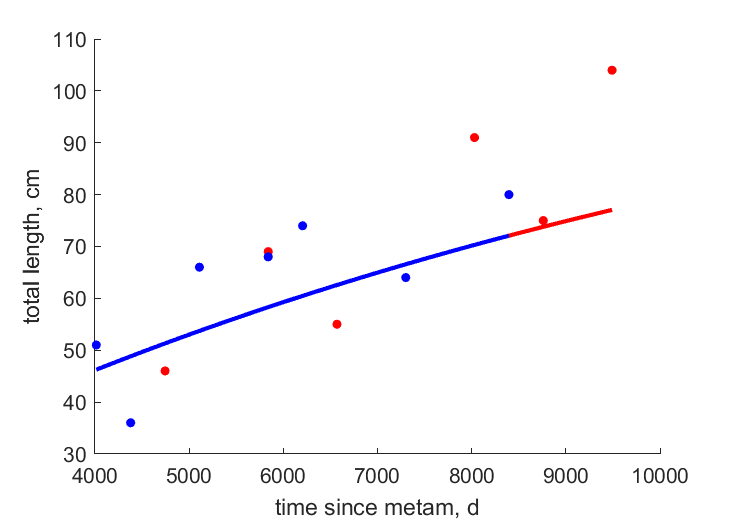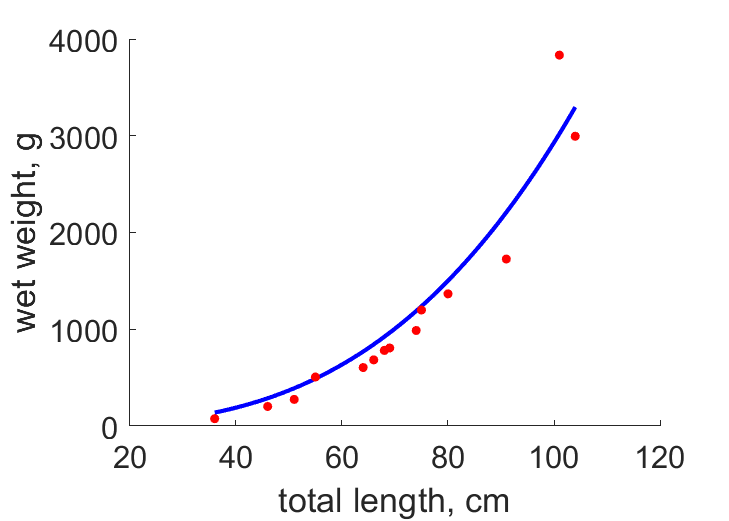Predictions & Data for this entry
| Model: ssj | climate: MB, MC | migrate: | phylum: |
| COMPLETE = 1.5 | ecozone: MC | food: biCia | class: |
| MRE = 0.095 | habitat: 0iMpm, 0iMpb | gender: D | order: |
| SMSE = 0.026 | embryo: Mpm | reprod: O | family: |
Zero-variate data
| Data | Observed | Predicted | (RE) | Unit | Description | Reference |
|---|---|---|---|---|---|---|
| tj | 1095 | 984.8 | (0.1006) | d | time since birth at metamorphosis from leptocephaluys to juvenile | VediOrlo2016 |
| tp | 6570 | 6170 | (0.06086) | d | time since metam at puberty | VediOrlo2016 |
| am | 1.095e+04 | 1.095e+04 | (1.06e-06) | d | life span | VediOrlo2016 |
| Lj | 10 | 11.3 | (0.1296) | cm | total length at metam | guess |
| Lp | 55 | 60.29 | (0.09616) | cm | total length at puberty for females | VediOrlo2016 |
| Li | 122 | 123.5 | (0.01257) | cm | ultimate total length | VediOrlo2016 |
| Wwb | 0.00052 | 0.0004996 | (0.03922) | g | wet weight at birth | guess |
| Ri | 274 | 263.7 | (0.03755) | #/d | maximum reprod rate | guess |
Uni- and bivariate data
| Data | Figure | Independent variable | Dependent variable | (RE) | Reference |
|---|---|---|---|---|---|
| tL_f |   | time since metam | total length | (0.1791) | VediOrlo2016 |
| tL_m |   | time since metam | total length | (0.1449) | VediOrlo2016 |
| LW |  | total length | wet weight | (0.1828) | VediOrlo2016 |
Pseudo-data at Tref = 20°C
| Data | Generalised animal | Notacanthus chemnitzii | Unit | Description |
|---|---|---|---|---|
| v | 0.02 | 0.01892 | cm/d | energy conductance |
| kap | 0.8 | 0.9 | - | allocation fraction to soma |
| kap_R | 0.95 | 0.95 | - | reproduction efficiency |
| p_M | 18 | 17.35 | J/d.cm^3 | vol-spec som maint |
| k_J | 0.002 | 0.002 | 1/d | maturity maint rate coefficient |
| kap_G | 0.8 | 0.7999 | - | growth efficiency |
Discussion
- Males are not assumed to differ from females; VediOrlo2016 give tp=18yr at Lp=55cm for females and tp=14yr at Lp=66cm for males, while the scanty data do not support enough growth differences between sexes; Lm=122cm(unsexed) is 20 cm more than their max observed length
- temperatures are guessed, based on deep water occurence
Facts
- Leptocephalus larva lives in surface waters and can become larger than the adult, which lives 120 till 4900 m deep (Ref: Wiki)
- feeds on sea anemones, molluscs and echinoderms (Ref: Wiki)
- Duration of the leptocephalus-stage is unkown, 3 yrs in related species (Ref: VediOrlo2016)
Bibliography